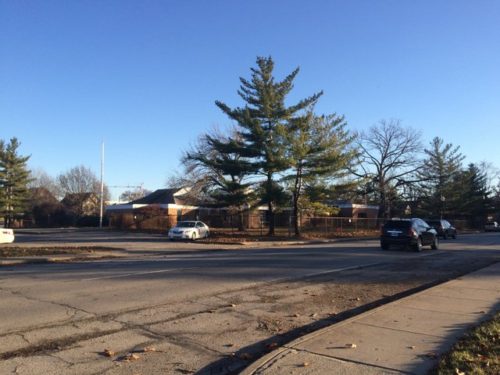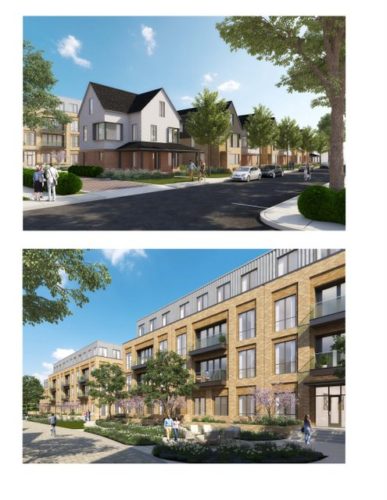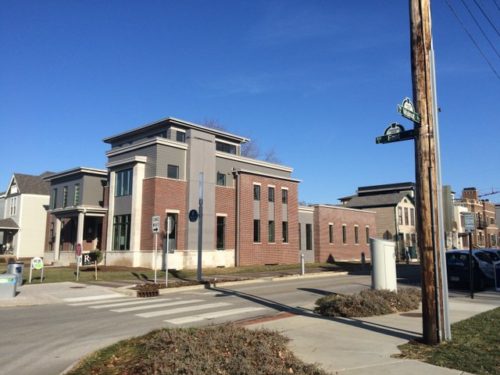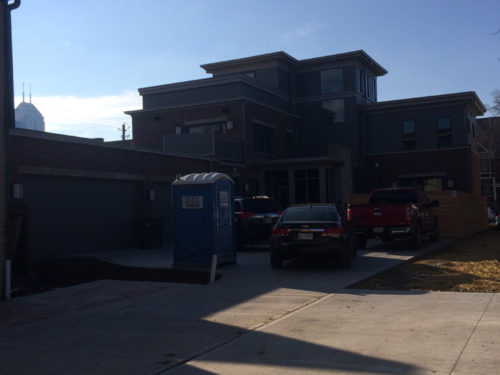I’ve covered the evolution of the Chatham Park proposal multiple times on this blog, so it might seem like overkill to feature it yet again. But it isn’t.

Why not? Because it hasn’t gone away. After multiple presentations before the Indianapolis Historic Preservation Commission (IHPC), it remains in an ambiguous state, neither approved nor disapproved. The IBJ covers the latest attempt thoroughly.  And, after the early-April meeting, it remains tabled, awaiting further changes until it meets the IHPC’s standards. In the meantime, we all get to look at the withering old school building, which the developer has allowed the neighborhood to use as an unofficial dog park for the last few years.
The primary entity stymieing its approval remains the same: the Chatham Arch Neighborhood Association (CANA). At this point, this organization is doing a brilliant job of ultimately snuffing the life out of this project by picking away at it, removing key features that contribute to the project’s density and intensity, little by little. After six months of hearings, the project survives, retaining much of its aesthetic and urban design integrity, but considerably reduced in scale. Here are two renderings of the latest proposal:

It’s still a fine mixed-use project with a smart design, contemporary but not overly faddish. However, this project cannot survive much longer if the bleeding continues. Death by a thousand cuts. Notice how much smaller its scale is from the original design introduced last fall. The developer has cut back on all that he can without completely undermining the proposal’s viability…and profitability.  His equity partners and lenders cannot tolerate any further dilution of the project because the internal rate of return will not be good enough. And if IHPC subjects Chatham Park to further reductions, the development team will have no choice but to withdraw the proposal. Which is undoubtedly what CANA wants.
Urban Indy strongly supported this project from the start, thanks to its design sensitivity, its ability to target a new demographic, the creative architectural language, the landscaping, the subtlety of the parking, and the mixed-use character. It’s exactly the sort of infill that Indy needs to continue the momentum of reurbanizing its increasingly vibrant, walkable downtown, along with the density that helps the city restore its tax base, much of which it lost in the second half of the 1900s through suburbanization, middle-class flight/depopulation, and the shift in its sociopolitical culture induced by Unigov.
But Urban Indy is up against a powerfully organized force. CANA has never found a medium-density project that it likes, which explains why this project receives such opposition while a leviathan like this single-family home at East and Walnut streets (just a few blocks south of Chatham Park) gets no opposition whatsoever.

From its website, CANA claims that it, as well as the Chatham Arch Neighborhood Foundation, collectively seek “[t]o promote the preservation of the unique heritage of the area known as Chatham-Arch, an historic residential neighborhood, in Indianapolis, Indiana and to create a total urban environment with respect for the past developed and listed in the National Register of Historic Placesâ€. If the folks at CANA had a genuine interest in the heritage of Chatham Arch, they would have at least questioned the development of a single-family home that spans two parcels and includes a massive garage in the back.

(Yes, that’s a third garage behind the blue porta-john.) Nothing about a home of these dimensions, with this much cubic footage devoted to vehicles, remotely aligns with “a total urban environment†or the character of the homes that earned Chatham Arch recognition from the NRHP.
But our concern is Chatham Park, which depends on the support of Urban Indy readers, IBJ commenters, and people in the Chatham Arch neighborhood who genuinely seek a vibrant urban setting, which ostensibly is the reason the land in the neighborhood commands such high prices.
The next IHPC meeting is May 3, 2017 at 5:30 pm in the second floor of the City County Building. Be there! Without a visible “I support†presence at this meeting, the IHPC will subject it to further conditions per the directions of CANA, and the deal will collapse. Here are the most essential points that we in Urban Indy have identified:
- True historic preservationists support improved density. CANA claims to respect historic character, but density—a fundamental aspect of that neighborhood’s character—is irrelevant. If it were, the leadership at CANA would advocate restoring the area’s population to something closer its 1940 peak, when the census tracts around Chatham Arch had 28,000 people. In 2010, they had 8,000. So the area would still have to grow 3.5 times to reach its historic levels. While no one among us ever expects it to return to 1940 (today’s household sizes are far smaller), we’ll be lucky to approach 50% of historic density if we continue at Cana’s preferred development pattern. And Indy remains in the bottom quartile of major cities in terms of population density. And low density cities suffer a proportionally higher per-person burden to deliver government services.  Furthermore, the historic character of Chatham Arch includes other high-density apartment buildings, as well as a smattering of retail and industry.  The only history CANA respects is one of single-family homes with yards, separation of uses, rigid standards for on-street parking…in short, a suburban vision imposed on downtown Indianapolis.
- For those who don’t want “those types†moving in, they have nothing to fear. Anxiety about low-income populations moving into the proposed Chatham Park development, articulated by some of CANA members, are unfounded. This is market-rate development, and the market is hot. Additionally, it’s going to be owner-occupied, so the chances that, due to future neglect or poor management, the development could eventually downgrade to housing credit voucher programs or low-income, is virtually nil. In fact, as the downtown apartment market shows early signs of cooling, the next best option is owner-occupied housing, which also must pay closer attention to design and quality because—not surprisingly—prospective homebuyers tend to be choosier than renters.
- If not here, then where? So much of the CANA attitude falls under this rubric: “It seems like a good project; we just don’t want it to go right here.†Don’t let this mantra seduce you. It has all the trappings of the “drawbridge mentalityâ€â€”of people who rushed into their piece of Eden, but now want to horde it for themselves. If that sounds like a melodramatic descriptor, bear in mind these people are fighting what another person seeks to do with his land. They have no investment stake in this parcel; they are neighbors. And while guarding against potential decline in property value is a rational human behavior, they are fighting investment in land—which overwhelmingly enhances land values—versus letting it sit fallow and underutilized, which overwhelmingly reduces it. And, NIMBYs (yes, I used that word) always want to push the investment to someone else. The problem is, precious little of Indiana’s land area has the zoning, infrastructure, or market demand to support medium-intensity development. If this area can’t be urban, what in Indiana ever will be? Regardless of whether you think urban neighborhoods are the key to attracting new professional talent, you can at least recognize that a diverse portfolio is better than a lopsided one. And, for the sake of diversifying our state’s homeownership offerings, wouldn’t it be savvy to let cities be cities? No developer is gunning to build high-density housing in the hinterlands, yet here we have an interest group forcing rural/suburban development patterns less than a mile away from the absolute center of the state’s largest city.
- Does the rest of Indianapolis wish to submit to bullying? Again, I know that such a label seems like hyperbole. But the dialogue on our previous blog articles suggests that most outside observers feel that’s exactly what CANA has been doing. I’ll concede that we are not an unbiased blog source: we are advocates for good urban development. But then, compare to the Indianapolis Business Journal articles—a much broader range of views, and more impartial—and the overwhelming majority still favor Chatham Park and refer to CANA as bullies—particularly a few of the most visible and vocal (i.e., the ones front and center at IHPC meetings). CANA is notorious for not welcoming new members if they don’t share their anti-growth views.  And while it’s only hearsay, I have strong evidence that one member of CANA actually liked the project; he voted against it simply because he didn’t want to endure the wrath of the most ardent anti-urbanists at CANA, who are his neighbors. CANA is remarkably organized with mission of fiercely supporting their status quo. If they continue to show up as a bloc at IHPC meetings, they deserve to win. But if they win, it only substantiates the notion that organized obstructionists get the upper hand, helping not just CANA in the future, but other neighborhood associations hell-bent on keeping Indy low-density.
  Â
Thus, I can only urge our readers get to work early that day, call a babysitter, wait till later that night to watch the game. While I’ll avoid hyperbole this time and say that Chatham Park is not the straw that broke the camel’s back, its failure will likely make it much harder to promote good urban development in downtown Indy for the foreseeable future. Chatham Arch, an attractive but tiny neighborhood that remains a wraith of its former self, should to be something Indy can be proud of. Indy deserves it.
For more details on the proposal, visit the Chatham Park website at MyChathamPark.com . While we encourage all supporters to attend the May 3 meeting at 5:30pm in the City-County Building, a letter of support to the City’s Principal Architectural Reviewer will also help, no matter how brief. These letters should go to meg.purnsley@indy.gov .
I’m going to show up and support Chatham Park. I think it’s a great development.
I’m sympathetic to CANA’s concerns and CANA’s logic for what they see as the historic character of their neighborhood: They see single family dwellings, not density, as the salient point. With no historic building to protect on this plot, that’s what the argument boils down to: Single family residences vs. historic density.
With changes in society, we can’t return to both the single family dwellings AND the density that this neighborhood had in the past. I’m firmly in the historic density camp, particularly given all the bending over backward this developer has made to compromise — putting all of the density on the very edge of the neighborhood, across from a high-rise.
Thanks Andy. You echo the sentiments of a person with whom I consulted in the creation of this article. I’ll leave this person anonymous, but it was very well-put IMO:
“While I can see the argument for greater density along this atypical section of CA, I also get the argument that even huge houses are still single-family homes so aren’t stretching the view that CANA has adopted for its neighborhood. When the neighborhood was holding up Larry Jones mixed use development based in this single family residence theory I [recognized that the area] included industrial and multiresidence dwellings. My point was/is that the argument of historic single-family dwellings is only historic if you are picking your timeframe very carefully cause CA has had a variety of use types thru much if its history. Not sure that answers your question but it was what stuck out at me previously about the single-family pretension.”
You nailed it, Andy.
I had the opportunity to meet the developer last night at Aaron Renn’s Indy meetup. Paul is a genuine and nice guy and I am sorry that he has gotten caught up in this. His original project was great; this one is “OK”, but as you say, it just can’t go any smaller.
It’s really puzzling that the neighbors would rather look at a vacant building and grounds than well-designed new homes for new neighbors.
It’s also puzzling that the neighbors are so shortsighted about their own properties’ future: who will buy their houses when they’re ready to sell? Having “move-up ready” residents already familiar with the neighborhood through living in this development will only increase demand for their properties.
Indeed, it’s hard to know who they’re hoping to accommodate besides their own restrictive, very outmoded view of what will protect their property values. Sure, constraining supply will increase value in the short term, but what if the bubble bursts from all that artificially restricted efforts to curb growth. And ultimately they’re giving themselves a reputation of being hostile to outside ideas…and the outsiders themselves.
When I used to live in New Orleans, they had a fantastic redevelopment of an old streetcar terminal into a Whole Foods. Very pedestrian scaled, with subtle parking in the back–a wonderful integration to the neighborhood. But the neighbors fought fiercely to block it, claiming it would cause a traffic nightmare, and I believe for a time the developer pulled out. Which meant that the neighbors had fought to preserve a rusted-out, blighted old structure instead of an investment.
I am in favor of the development but it is a bit much to suggest we have any ideas what future property vales in the neighborhood will be, particularly 5, 10, or 15 years out. And the neighborhood has a wide range of price points and property sizes. So many variables beyond our control influence those values, and this development is but one of them.
8,000 residents in 2010. Yet the first vote was something like 23 against and one opposed. I do not believe that 23 people represent the majority of the neighborhood. Yet, CANA testimony states overwhelmingly majority of opposition and they do not give the vote count. Why? Because leaving out the fact that only 24 people voted in a neighborhood of 8,000 reduces the credibility of the opinions of an overwhelming minority. Further, the testimony frequently mistakes the facts in parking and retail history of the neighborhood in order to back up their minority’s views. They have lost complete credibility. I am a resident and feel bullied and welcome if I express pro views. I believe they have less than 100 members. They have an endowment under $2 million. They should have bought the property themselves and controlled the development by reselling the land to a developer that would build their preferred views. I don’t feel comfortable voting no at CANA meetings because of the rude remarks. I have heard people say that they want a low supply so their prices increase. Why is their no diversity or inclusion in the neighborhood? Maybe that’s an issue that should be a focus?
8000? What?
It’s important to point out how particularly pernicious this brand of NIMBYism is. As Eric notes, it’s natural for those who own their homes to want to protect their property values. But it’s important to note why Chatham Arch property values are high. While many of the homes are beautifully restored, the property is so valuable not because of the attributes of the property itself, but because of amenities that all of us pay for: government jobs paid for by all of the citizens of Indiana and/or Marion County, Banker’s Life Fieldhouse, Lucas Oil Stadium, the Murat, Circle Theater, loads of restaurants and bars and shops that are regional draws and could never be supported by the neighborhood alone. It’s one thing to live in the middle of a cornfield in central Hamilton County and seek to keep one’s piece of the world unchanged. It’s quite another for someone to try to hoard proximity to amenities that don’t belong to them.
I meant unwelcome in my earlier comment. Spell check. Also, here is the scam of it all. Let’s say Joe Blow is a member of CANA and a member of CANA Urban Design Committee. Joe Blow has no design or architectural expertise other than sharing anti density views. The CANA President testifies that the CANA vote is an overwhelming majority without saying only 24 voted. Joe is one of those votes. The head of the Urban Design Committee testifies that UDC is against. Joe is again one of those votes. Then Joe testifies he is against. Joe’s one vote against is represented three times at the hearing. Then you throw in the testimony that includes bad facts and made up neighborhood history and it all turns into a circus of statements intended to illustrate the destruction of humanity if the development moves forward. Plus, there is no mention of the developer matching grant offer for $10,000 toward a new dog park. $5,000 for children’s playground and $5,000 to replace historic fountain at Park and Mass Ave. They hate the development and their actions are hate against the developer and disdain for pro development neighbors by saying I lived here longer than most people so my opinions matter more. As you can see, I am frustrated and disappointed in the character of CANA as a credible organization. They do not represent the 8,000 residents.
Joe, I respect your views these last few months–it sounds like you’re one of the people whom CANA is bullying. If you don’t feel comfortable showing up next Wednesday, I urge you to convey these sentiments in a brief letter to Meg Purnsley. You should still be able to keep it anonymous if you wish.
We’ve had the “two bites of the apple” problem in Fletcher Place as well where people lobby for a stance in the Land Use Committee, then proceed to send a personal letter as well. I’ve been trying to get FPNA LUC to develop general policies regarding land use and apply those policies with limited judgment to developments that come along.
So far we haven’t gotten very far, but hopefully we can make more progress.
The whole process is so politically fraught.
This project better go through, enough with NIMBY’s in indianapolis killing development.
Approved! That was a long meeting and process.
Build on…
Anything recent on this one?